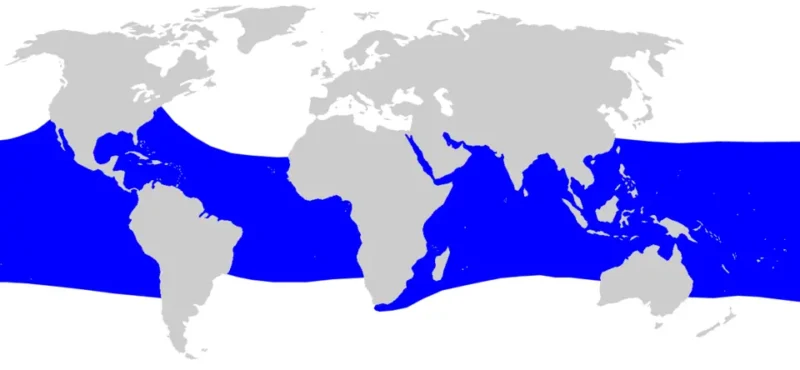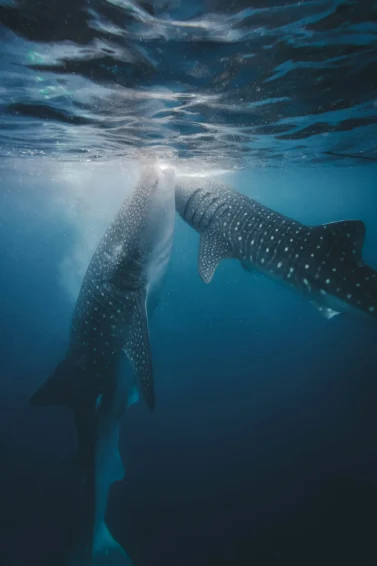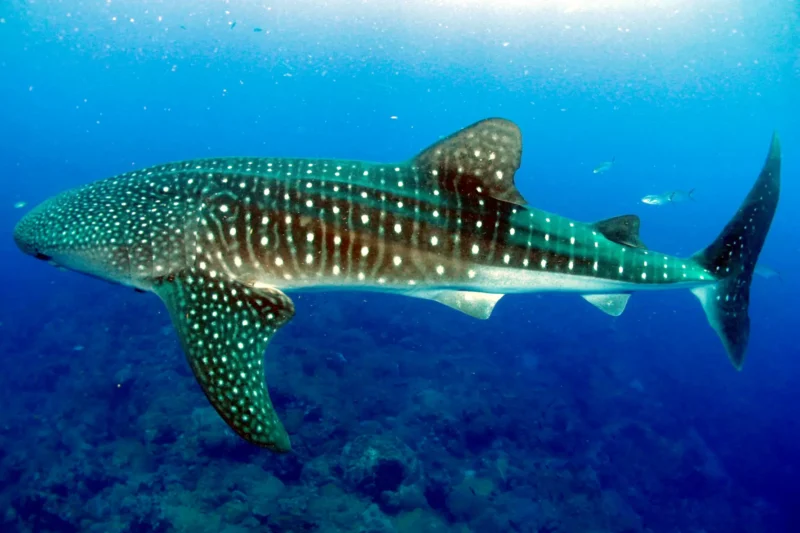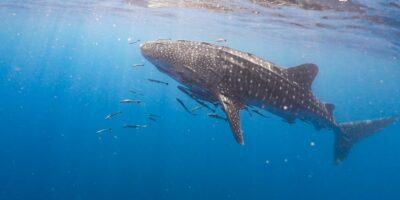Body Structure, Characteristics & Anatomy
The Whale Shark (Rhincodon typus) is considered a gentle giant of the oceans. Reaching lengths of up to 18 meters and weighing several tons, it is one of the most impressive representatives of sharks. Despite its enormous size, it primarily feeds on plankton, small fish, and crustaceans, which it filters through its specialized system. It is of particular interest to science and conservation due to its unique adaptations to life in the open sea.
The impressive body size
The Whale Shark is the largest known fish on Earth. Its body shape appears massive, yet it is a skillful swimmer. The broad, flattened head carries an enormous mouth, which can be up to 1.5 meters wide. Through this, it takes in thousands of liters of water daily to filter out food. Despite its size, it moves slowly, gliding gently through tropical and subtropical waters.
Anatomical Features
Characteristic of the Whale Shark are its five large gill slits, through which it filters water and food. It has tiny teeth, which are hardly used for feeding. Instead, specialized gill rakers ensure efficient filtration. Its skeleton, like that of all sharks, is made of flexible cartilage, combining lightness and stability. This allows it to swim energy-efficiently despite its massive size.
External Features
The most striking feature of the Whale Shark is its skin pattern. The body is dark gray to bluish and covered with light spots and lines that resemble a mosaic. This pattern is unique to each individual and functions similarly to a fingerprint. Researchers use these markings to identify individual animals and track their movements. The skin of the Whale Shark is extremely thick, providing protection against injuries and parasites.
Differences between males and females
The distinction between male and female Whale Sharks is not made by body size alone, but by specific anatomical features. Males have so-called claspers – paired extensions on the pelvic fins used for reproduction. Females do not have these structures, allowing for clear identification.
Physical Differences
Female Whale Sharks reach larger final sizes on average than males. They can grow over 14 meters long, while males usually remain somewhat smaller. These differences are likely related to reproduction, as females need additional space for the development of numerous embryos. Studies indicate that females can produce several hundred offspring over their lifetime.
Distribution & Habitat
The Whale Shark (Rhincodon typus) is found in all tropical and subtropical oceans. As the largest fish in the world, it prefers warm waters rich in plankton and small fish. Its lifestyle is closely linked to food availability and seasonal currents, which is why it undertakes long migrations.
Geographical distribution
Whale Sharks are found across large parts of the Atlantic, Indian, and Pacific Oceans. They are especially common near the coasts of countries such as Mexico, the Maldives, Mozambique, and the Philippines. They are also regularly observed in the Red Sea and along tropical island chains like the Seychelles and Galapagos Islands. In temperate zones, Whale Sharks are relatively rare, as the water temperatures there are too low for their lifestyle.

Habitat in the Ocean
The Whale Shark prefers open ocean areas but often also moves in coastal regions. Especially where plankton blooms occur or fish eggs are abundant, the animals gather in groups. These gatherings, also called aggregations, are mainly observed during certain seasons. Dozens of Whale Sharks can come together in one place to feed collectively.
Depth and Areas of Occupancy
Whale Sharks are primarily found at the sea surface, where they obtain most of their food. However, they are capable of diving to depths of over 1,000 meters. Such dives are likely for foraging or energy conservation. Their ability to move between different water layers makes them flexible inhabitants of the oceans.
Factors Influencing Distribution
The distribution of the Whale Shark is strongly influenced by water temperature, currents, and food availability. Seasonal changes, such as plankton blooms or the spawning of certain fish species, affect their migrations. Studies have shown that Whale Sharks can travel thousands of kilometers to reach suitable feeding grounds or breeding areas.
Lifestyle, diet & reproduction
The Whale Shark (Rhincodon typus) is one of the most admired marine creatures. Despite its enormous size, it is considered a peaceful plankton feeder, posing no threat to humans or larger animals. Its lifestyle is largely determined by foraging and seasonal migrations. There are also intriguing insights into its reproduction, which has so far been only partially studied.
Lifestyle of the Whale Shark
Whale Sharks lead a largely solitary life, but at certain times they gather in larger groups at abundant feeding grounds. These gatherings are often linked to seasonal plankton blooms or the spawning of fish species. Outside of such events, Whale Sharks mostly roam alone through tropical and subtropical oceans. They cover enormous distances and are considered enduring migrants, capable of adapting flexibly to different currents and environmental conditions.
Diet
The diet of the Whale Shark is unique. It feeds mainly on plankton, small fish, krill, and other tiny organisms. Its enormous mouth allows it to take in many thousands of liters of water daily, which it filters through its gills. Whale Sharks use two methods: they swim with their mouths open through nutrient-rich waters, or they actively suck in water and then push it through their filtering structures. Their tiny teeth play almost no role, as feeding occurs almost entirely through the filtration system.
Reproduction
Little is known about the reproduction of the Whale Shark, as observations in the wild are rare. It is certain that Whale Sharks are ovoviviparous – meaning the embryos develop in eggs inside the mother’s body and are born alive. Females can give birth to several hundred offspring, with the young already measuring around 50 to 60 centimeters at birth. Interestingly, fertilization can occur over extended periods, allowing females to carry offspring for years. Male Whale Sharks are identifiable by their claspers on the pelvic fins, which are necessary for reproduction.
Interaction with people
The whale shark is considered the largest fish on Earth. Despite its impressive size of up to 12 meters in length, it is completely harmless to humans. Around the world, it fascinates divers, snorkelers, and marine researchers who wish to encounter it in the wild. The interaction between humans and whale sharks has gained increasing importance in recent years—both as a tourism factor and for the protection of this endangered species.
Why the whale shark is fascinating for humans
The very first look at its enormous body with distinctive white spots and stripes leaves a lasting impression. Unlike other sharks, the whale shark feeds exclusively on plankton, small fish, and crustaceans, which it filters through its gigantic mouth. Its peaceful behavior makes it an ideal ambassador for the underwater world. Many people describe an encounter with a whale shark as profoundly moving and unforgettable.
Encounters while diving and snorkeling
Whale sharks often appear in regions where they seasonally gather to take advantage of plankton-rich waters. In places like Mexico, the Maldives, or the Philippines, this has led to the development of entire ecotourism offerings. The animals usually approach the water surface slowly, giving snorkelers and divers the opportunity to observe them in their natural habitat. However, swimming with whale sharks requires consideration and strict rules to avoid disturbing the animals.
Rules for Responsible Interaction
To ensure whale sharks are not endangered by human proximity, many countries have established codes of conduct. These include maintaining minimum distances of several meters, prohibiting touching, and limiting the number of people in the water at the same time. Boats must also reduce their speed to prevent collisions. Such rules protect the animals while allowing humans to have a respectful and sustainable encounter.
Tourism, Conservation, and Research
Ecotourism surrounding the whale shark brings economic benefits to many coastal communities. At the same time, part of the revenue is often invested in the protection of the animals. Researchers also use encounters with whale sharks to document their migrations, behavior, and populations. These data are crucial, as the whale shark is listed as endangered on the IUCN Red List. Every interaction between humans and the animals can thus contribute to greater knowledge and conservation.
Threat & protection status
Conservation Status of the Whale Shark
The International Union for Conservation of Nature (IUCN) lists the whale shark as endangered on the Red List. This classification means that the species is experiencing a significant population decline and faces a high risk of extinction without protective measures. The Washington Convention on International Trade in Endangered Species (CITES) also lists the whale shark in Appendix II, strictly regulating its international trade. Additionally, many countries have enacted national protection laws prohibiting capture and commercialization.
Main Threats to the Whale Shark
The greatest threat to whale sharks comes from fishing. Although they are not aggressive, they are often caught accidentally as bycatch in large nets. In some regions, they are also targeted for their meat, fins, or oil. Collisions with boats also pose a significant risk, as whale sharks often swim near the water’s surface.
Another factor is environmental pollution. Plastic waste is increasingly entering the oceans and can be ingested by whale sharks along with plankton. Climate change also alters plankton distribution, threatening the animals’ food supply. This combination of human impact and ecological changes puts significant pressure on whale sharks.
The Role of Ecotourism
Tourism can be both a curse and a blessing for the whale shark. On one hand, it provides economic incentives that can contribute to the protection of the animals. On the other hand, uncontrolled tourism can cause stress and disrupt their natural behavior. Strict rules and responsible operators are therefore essential to ensure that tourism makes a positive contribution in the long term.
Research and International Collaboration
Scientific projects and international agreements are essential for better understanding the migrations and habits of the whale shark. Satellite telemetry, photo identification, and DNA analyses provide important data that serve as the basis for conservation programs. Only through close collaboration between coastal states, environmental organizations, and the scientific community can the decline be halted.
Keeping in Aquariums
The whale shark is considered the largest fish in the world and exerts a tremendous appeal on humans. While most encounters occur in the wild, there are a few aquariums worldwide that keep whale sharks. However, this practice is highly controversial and has sparked an intense debate between supporters and critics for years.
Why Whale Sharks Are Displayed in Aquariums
Some large marine aquariums, especially in Asia, have housed whale sharks in enormous tanks. Operators argue that visitors develop a stronger awareness of ocean conservation through direct encounters with the animals. Additionally, the animals serve as a flagship attraction to draw tourists from around the world. In some cases, research projects are also cited, allowing the observation of whale shark behavior and feeding.

Challenges in Keeping Whale Sharks
Whale sharks are ocean wanderers, covering thousands of kilometers in the wild. This lifestyle is nearly impossible to replicate in captivity. Even the largest aquarium tanks provide only a tiny fraction of their natural habitat. Problems such as restricted movement, stress, and injuries from collisions with tank walls have been documented. Feeding is also challenging, as whale sharks require large amounts of plankton, which is difficult to simulate in controlled environments.
Criticism from Animal Welfare Organizations
Numerous animal welfare organizations strongly criticize the keeping of whale sharks in aquariums. They argue that the animals cannot live naturally in captivity and often have a significantly shortened lifespan. There is also the ethical question of whether it is justifiable to remove such migratory animals from their natural environment. For many experts, the negative aspects clearly outweigh any potential benefits.
Alternatives to Keeping Whale Sharks in Aquariums
Instead of displaying whale sharks in captivity, more and more organizations are focusing on education through documentaries, virtual reality technologies, or guided excursions in the wild. These approaches allow impressive experiences without restricting the animals’ freedom. They also help link tourism with marine conservation in a sustainable way.


















